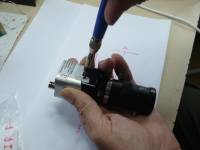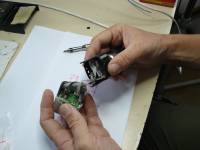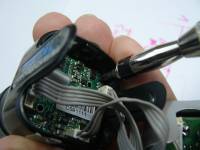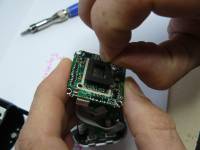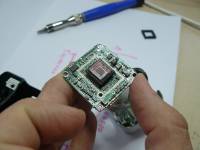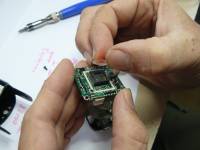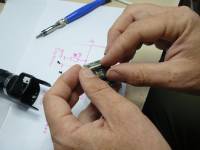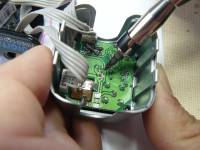Table of Contents
Visual Meteor Detection Station VMDS01A
Technical equipment
Following technical equipment is used by a visual meteor detection amateur network CEMeNt.
Lens
The lens has to be sufficiently wide angled and luminous - conditions so far best met by Tokina 3-8.2 mm F0.98 (IR).
A use of KPF 131HR camera
KPF 131HR camera is originally designed for building surveillance and thus requires several technical changes in order to make is suitable for usage.
IR filter removal from CCD chip
LED disconnecting
At the back of the camera you find a continuously shining LED, that might cause reflections from the front cover glass at night. It is therefore recommended to disconnect it during the IR filter removal.
Camera settings
PRC correction? Dark frame?
Before usage the camera has to be set as follows:
- exposition 1/50 s
- aperture control DC
- BW regime
- AGC to middle
- brightness ca. 75
ImagingSource camera
The manual uses DFK 72AUC02 camera.
How to make the camera work in Ubuntu
upgrade of the camera firmware was done according to instructions with 2 exceptions:
- sudo ./euvccam-fw -u ../../data/firmware/usb2/dmk72uc02_129.euvc
Now it is possible to see the camera in /dev/video0
2. Further it is necessary to install ucview exactly according to instructions and then to install libunicapgtk2 from Ubuntu repository.
sudo apt-get install git autoconf libtool libgettextpo0 gettext gtk-doc-tools libraw1394-dev libpango1.0-dev libgstreamer0.10-dev libxv-dev libgtk2.0-dev libgconf2-dev libglade2-dev libglade2.0 libglademm-2.4-dev libgstreamer-ocaml-dev libgstreamer-plugins-base0.10-dev git clone https://github.com/unicap/unicap.git ; cd unicap cd libunicap ./autogen.sh ; ./configure ; make ; sudo make install cd ../libucil ./autogen.sh ; ./configure; make; sudo make install cd ../libunicapgtk/ ./autogen.sh ; ./configure; make; sudo make install
Compile the ucview.
git clone https://github.com/kaklik/ucview ; cd ucview/trunk cd ucview ./autogen.sh; ./configure; make; sudo make install cd ../ucview-plugins/ ./autogen.sh; ./configure; make; sudo make install
make; sudo make install
To test if everything got compiled fine run
ucview
Note: On some system you may need root privileges while running ucview to get your camera working.
Issues with the currently used cameras
- Signal transmission is not possible over longer distances (in orders of meters). This means that computer has to be very close to the cameras usually under often problematic weather conditions.
- Small angular resolution of camera
- Small dynamic range
TODO
- Software for synthesized all sky camera.
Protection of camera
Camera placed in a way that it has a direct view to the ecliptic has to be protected against direct sunshine that may damage the CCD chip.
It is customary to use a timer, that would close a camera shutter during a day by means of cutting off the power source. time protection of camera from the direct sunlight
This method is not very advantageous because of the additional timer, that could be replaced by the station's computer. Moreover, the situation could be addressed using the same method as in MRAKOMĚRu4.
Software
MetRec
MetRec is a freeware software that uses its own Matrox Meteor II card (has to be purchased) to grab the signal.
UFOCapture
UFOCapture is a proprietary software for Windows. It works with any grabbing hardware.
AZcendant
Visual observer
The drawbacks of the currently used programmes for automatic detection of meteor trails could be addressed by a new OpenSource software. It is so far still just a concept - comments are found here: Redmine.
A final version of detection software should use an OPSA01A based camera as an visual data input.
The synthesis of all-sky image
All-sky camera system (composed of more cameras) directly plots a coordinate system to the captured image depending on the current time. At the same time it is possible to use an automatic detection of key objects found in the image.
Data usage
Bolidozor
Bolidozor network can make use of the observed data to detect and further search for the bolides.
Meteorology
Because station's cameras should be directed in a way that they cover the whole sky, the data can be theoretically used for meteorological applications. Cloud cover observed at small distances from below can provide useful information concerning the occurrence of updrafts, storm parameters or moving of fronts.
Using photometry we can measure the height of cloud base, its thickness or the extent of the cloud cover.
Other useful output may be the measure of the concentration of dust and aerosols in the atmosphere.
3D image reconstruction
References
- CEMeNt network
- An illustration of station realisation on Svákov observatory

